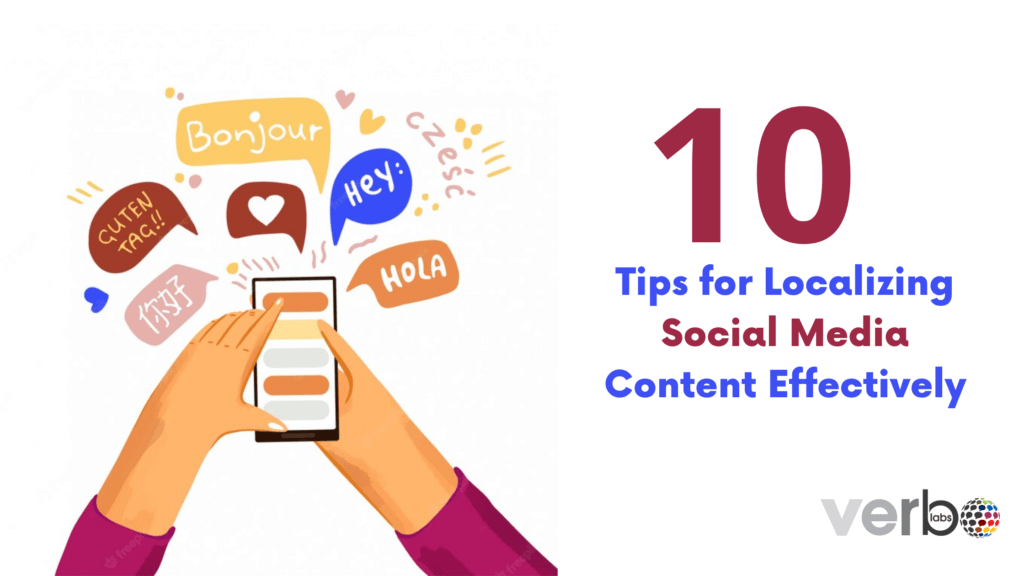Social media is a key tool for connecting with clients in the modern era. Localization on social media is necessary for brands to connect with customers worldwide. According to reports, 3.6 billion people used social media actively worldwide in 2020, and by 2025, that figure is predicted to increase to over 4 billion. Social media marketing provides a plethora of chances to interact with a huge global audience. You find it challenging to interact with your target audience on social media due to the language barrier. Only about 19% of people worldwide speak English as a first or second language, so brands shouldn’t disregard social media translation. Localizing social media is a great approach to take use of the strength of social networks and reach clients in the proper locale and tongue. Localized social media also aids in the development of extremely relevant and focused marketing.
The two continents with the fastest internet growth are Asia and South America. The languages that are most widely spoken in these places also have the fastest rate of global expansion. The number of speakers of Chinese, Spanish, Hindi, Urdu, and Portuguese has all significantly increased recently. In order to localize content, elements other than words must be changed to fit cultural norms.
We’ll go over the top tips for localizing social media content effectively:
- Choosing the right platforms to be localized
- Choose the right content to be localized
- Create separate social media pages for each country
- Use geo-targeting option
- Use influencers to localize social media content
- Work with linguistic professionals with experience
- Use innovative translation tools
- Be mindful of text expansion
- Content tone adaptation
- Accommodate users’ experience
- Localize appearance
1. Choosing the right platforms to be localized:
The first thing to think about before localizing social media is choosing the appropriate platform. Every nation has a distinctive platform that is widely used and popular. Twitter, Facebook, Instagram, and YouTube are all prohibited in China, the country with the largest social media market, thus localizing these platforms to draw Chinese users won’t be successful. A business should localize WeChat, and Weibo to cater to Chinese consumers. Although Russia does not have a ban on Twitter, Facebook, Instagram, or Youtube, the majority of Russians have VK profiles. So, the thing is to choose the right platform that needs to be localized in order to connect with the majority of people. You can switch to a smart language translation service provider who is a certified translation service provider:
2. Choose the right content to be localized:
Selecting the appropriate material is essential for social media localization because all of your information will not be effective for locals. Local festivals, holidays, seasonal items, news, and pertinent social topics are among the social media material that needs to be localized for local users. As an illustration, Australia starts preparing for winter in April, the US for spring, and India is already bracing for a sweltering summer. Therefore, localized social media material should be pertinent to the area.
3. Create separate social media pages for each country:
Posting information that is appropriate to culture and location will be made easier with separate social media profiles. Customer interaction will rise as a result of the carefully selected material on nation-specific social media profiles.
4. Use geo-targeting option:
Geo-targeting enables the customization of social media material for users in a particular geographic location, such as a particular country, city, or even zip code. For instance, two nations are playing cricket, and the citizens of these two nations are too preoccupied to cook since they are too busy watching the game. In that instance, a food delivery service can encourage residents of those nations to order food online and may even make special incentives to entice additional clients.
5. Use influencers to localize social media content:
Most individuals purchase the things that influencers they respect promote. A blogger, YouTuber, actor, athlete, singer, or another person can be an influencer. To operate a marketing campaign, local influencers can successfully localized social media material.
6. Work with linguistic professionals with experience:
The first prerequisite for effective localization of social media is an accurate translation. Targeting regional markets and native tongues requires skilled and seasoned translators. A translator needs to be familiar with the idioms, phrases, and cultural quirks of a certain area. With more than 3000 translators on staff, White Globe can provide translations in more than 350 different languages.
7. Use innovative translation tools:
When translating content on a wide scale, manual translation can be time-consuming and expensive. Use of computer-assisted translation (CAT) techniques is advised in certain circumstances. White Globe has AI- and human-powered translation solutions that produce high-quality translation quickly and widely.
8. Be mindful of text expansion:
The text may contract or expand as it is translated from one language to another. The text translation increases by 300% when it is translated from English to Russian. An expert in localization should be aware of it. The same holds true for voiceovers. The video needs to be modified again if the voiceovers are sometimes longer than the actual footage.
9. Content tone adaptation:
Every culture has its own voice. Getting to know the locals would help you adapt to their culture. Young individuals and older people communicate in different ways according to their cultures. Different communication standards apply to the two sexes. If a product is intended for young people, its social media material should be too. Young people communicate using jargon, slang, and colloquial terms. The target audience will be attracted in greater numbers if all of this is put into practice.
10. Accommodate users’ experience:
The target audience should be taken into account when localizing every part of the social media material. Each nation has its own time and date format, measuring units, currency symbol, and address format. When localizing social media, all of these considerations should be taken into account. Customers benefit from a personalized experience because of these simple elements make a big difference.
11. Localize appearance:
Your target audience’s people, locations, and cultural allusions should be featured in your social media posts. An obvious geographic giveaway can be a flag of the wrong country flying in the distance, a famous building from another country, or a car driving on the “wrong” side of the road.
Concluding to the above words
Localizing social media content, which involves more than merely translating language and using the same assets worldwide, is the key to breaking into a new market. Instead, it calls for performing in-depth audience research, collaborating with regional influencers and translators, and using cutting-edge translation software. One of the best language translation agencies in India is VerboLabs. Their products and services help companies better understand their clients, break down language barriers to market entry, increase customer bases, boost revenue and sales, strengthen customer loyalty, and improve the effectiveness of marketing campaigns. Even while your social media presence may be popular at home, it doesn’t guarantee that it will also reach, engage, and inspire clients abroad. Localization in social media happens here!
Social media content cannot be widely implemented like a new logo or software update. Each regional market must have a common language with it, both linguistically and culturally. Direct translations of the text are not the only thing that can go wrong in target languages; similarly, graphics and even colors that are entirely fine in one market might be completely unacceptable in another. Green, for instance, represents things like freshness, health, and environmental sustainability in North American cultures. However, in some South American nations, it is a symbol of death.



